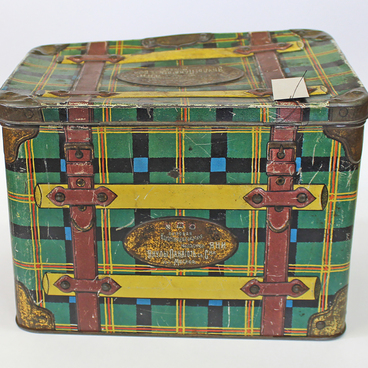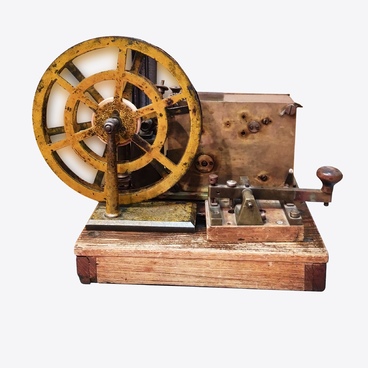The museum’s collection features this wooden chest from the late 19th century, designed to store clothes and other items. It is bound with metal and patterned tin. The metal is varnished, and it has shaped wooden legs, a lid with metal hinges, and an internal lock that can be locked with a key. On the sides of the chest are wrought iron handles.
The chest is decorated with gold-colored tin stripes in the form of a lattice, as well as square and triangular-patterned tin inserts. These patterns are made using the techniques of embossing and chromolithography on tin; the stripes and inserts are decorated with floral patterns of different colors.
This style of chest came to Russia from the East, and became widespread. The word itself (“sunduk”) is of Turkic origin, translated as “box”. Until the 19th century, the chest was master of all home furniture: during the day it was used as a bench, at night it was slept on. At the same time, it always served as the main repository for objects, jewelry and household items. Thus, the wealth of a family in Russia was measured by the number of chests it owned.
Our ancestors viewed the chest not only as a purely utilitarian object, but also as an element of the decoration of the home. Chests were sourced from various types of wood, mainly oak, beech and ash. One of the most popular techniques for decorating a chest, closely related to its functionality, was iron forging. But Russian craftsmen did not stop there: they came up with all sorts of original locks that rang and played music when opened. Often chests were covered with animal skins and beautiful fabrics.
Headrest chests were especially popular in the 17th century. Made in the form of a tortoiseshell, they served as a storage space for money and jewelry. When a person went to bed, he always put his headrest chest under the pillow.
In each region, chests had their own unique and recognizable appearance. The largest centers for the production of iron-bound chests in the 17th century were Novgorod, Kholmogory, Veliky Ustyug and Moscow. Craftsmen had their own techniques for decorating chests, but all together they created a single artistic image that turned an ordinary household item into a vivid example of Russian decorative and applied art.
The reorganization of life according to the Western model ousted the chests first from the chambers of the nobility, and two centuries later - from rural life. Now we can see how chests are starting to come back into fashion.
The chest is decorated with gold-colored tin stripes in the form of a lattice, as well as square and triangular-patterned tin inserts. These patterns are made using the techniques of embossing and chromolithography on tin; the stripes and inserts are decorated with floral patterns of different colors.
This style of chest came to Russia from the East, and became widespread. The word itself (“sunduk”) is of Turkic origin, translated as “box”. Until the 19th century, the chest was master of all home furniture: during the day it was used as a bench, at night it was slept on. At the same time, it always served as the main repository for objects, jewelry and household items. Thus, the wealth of a family in Russia was measured by the number of chests it owned.
Our ancestors viewed the chest not only as a purely utilitarian object, but also as an element of the decoration of the home. Chests were sourced from various types of wood, mainly oak, beech and ash. One of the most popular techniques for decorating a chest, closely related to its functionality, was iron forging. But Russian craftsmen did not stop there: they came up with all sorts of original locks that rang and played music when opened. Often chests were covered with animal skins and beautiful fabrics.
Headrest chests were especially popular in the 17th century. Made in the form of a tortoiseshell, they served as a storage space for money and jewelry. When a person went to bed, he always put his headrest chest under the pillow.
In each region, chests had their own unique and recognizable appearance. The largest centers for the production of iron-bound chests in the 17th century were Novgorod, Kholmogory, Veliky Ustyug and Moscow. Craftsmen had their own techniques for decorating chests, but all together they created a single artistic image that turned an ordinary household item into a vivid example of Russian decorative and applied art.
The reorganization of life according to the Western model ousted the chests first from the chambers of the nobility, and two centuries later - from rural life. Now we can see how chests are starting to come back into fashion.

